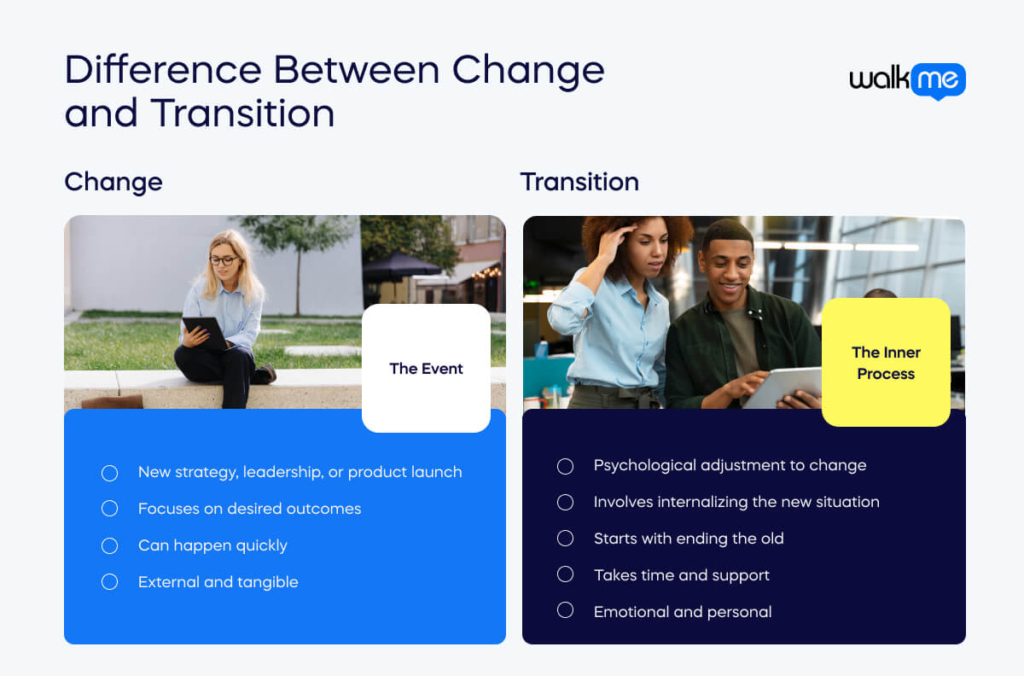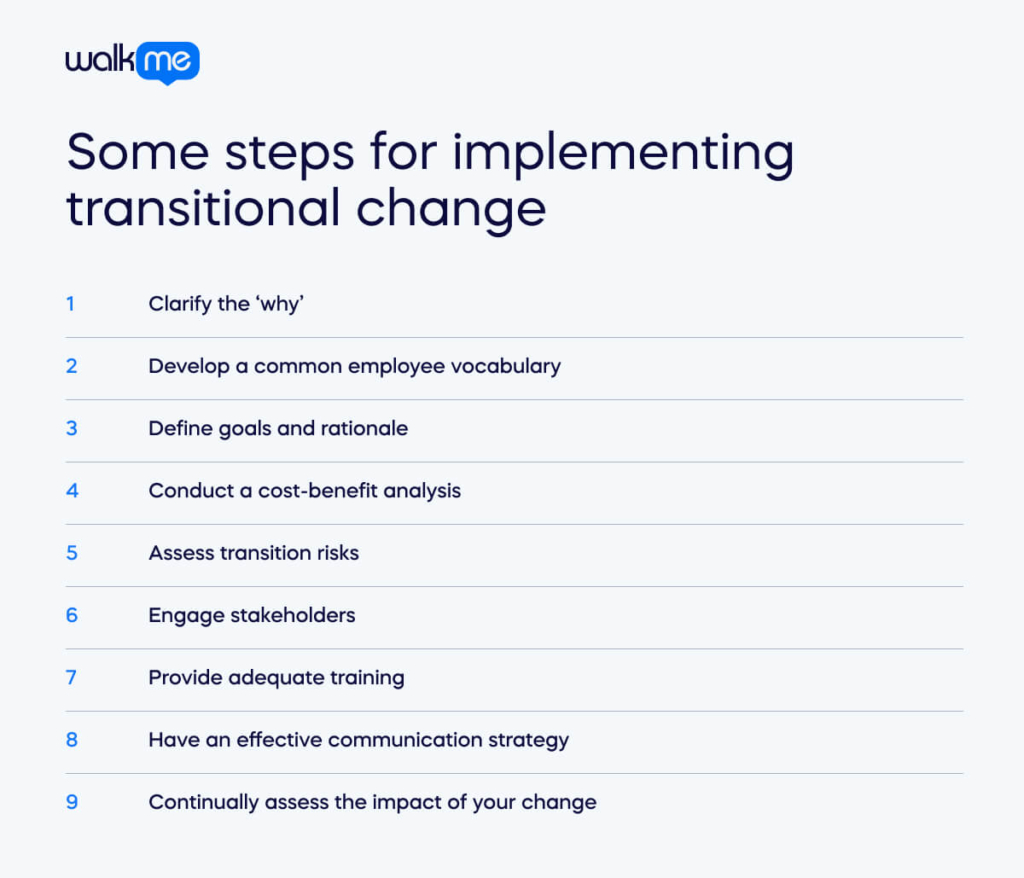Change management can be one of the most difficult things in any organization. In an era of rapid change, a company’s ability to adapt becomes a defining factor in its success. It involves more than implementing new technologies. It requires a better understanding of the different types of change and how to adapt strategies in the best way.
Transitional change requires a more complex approach. This type of change involves moving from a current state to a defined future state. It often requires significant adjustments in business processes, roles, and structures. Transitional change is predictable and well-structured, with a clear end goal and timeline.
In this article, we will define transitional change and its purpose. We will also explore the difference between change and transition and consider how to implement transitional change. Next, we will look at examples of transitional change and discuss its benefits and challenges.
What is transitional change?
Transitional change involves replacing the current way of doing things with something new. This requires planning and implementing a new system while phasing out the old one.
During this phase, the organization must let go of the old methods and adapt to the new ones. Traditional change management tools can support this process.
Examples of transitional change include reorganizations and mergers or acquisitions. It also involves launching new products or services that replace old ones. Next, it includes IT upgrades that don’t drastically change people’s work or need a significant cultural change.
Two key factors define transitional change:
- You can plan your destination in detail before starting. This allows for effective management of the transition.
- The impact on people is based on skills and actions rather than their mindset, behavior, or culture.
What is the purpose of transitional change?
Transitional change involves replacing existing systems, processes, and strategies with new ones. This type of change is more challenging to implement because it can create discomfort among employees.
Transitional change is also risky since the final outcome is uncertain. So, a well-thought-out change management strategy is essential for successful execution. Lewin’s change management model and the Satir change model can help with this strategy.
Unlike developmental change, transitional change is less frequent but has a larger scope and extent. When implemented, it gives an organization a competitive edge, helping it capture the market and expand to the next level.
Another key feature of transitional change is that leadership and management prepare a plan based on the change strategy. This plan is designed to implement the change within a specific time frame.
What is the difference between a change and a transition?

Change is an event or situation, such as a new business strategy, leadership change, or product launch. The business focuses on the desired outcome of the change, which can happen very quickly.
However, transition is the inner psychological process that people go through. As part of this, they internalize and come to terms with the new situation brought about by the change. Strong leaders know that any change causes worry.
The starting point for dealing with transition is not the outcome. Rather, it is the ending of something they know. This is because employees face having to leave the old behind.
Leaders and organizations can successfully manage a change if they consider the transition people experience during it. Supporting people through transition is essential for the shift to work as planned. This support is key to capitalizing on opportunities for innovation and creating business resilience.
What are some steps for implementing transitional change?

The key to preparing for transitional change is making a plan. This plan should outline the steps you must take to prepare for the transition and identify any problems that might arise.
Having a plan keeps you on track and stops you from feeling too stressed about the changes ahead.
Here are some elements that you can include in your next implementation plan:
Clarify the ‘why’
Successful business change begins with defining why change is necessary. Without this clarity, your team may struggle to implement it, risking failure.
Leadership must articulate a clear vision for the future that aligns with the change’s purpose. Overcommunicating this vision builds confidence and enthusiasm among employees about the change’s benefits.
Develop a common employee vocabulary
During change, establishing a shared understanding of goals and objectives is crucial. Leaders should communicate purposefully to help the organization transition from old ways to new directions.
Define goals and rationale
Detail quantitative goals and qualitative outcomes expected from the change initiative. Quantitative goals may include OKRs or financial targets. Qualitative aspects encompass improvements in workflows, employee satisfaction, and team culture.
Conduct a cost-benefit analysis
Perform a thorough analysis of the costs and benefits to understand the financial implications of the change. This analysis guides budget allocation and explores alternatives to achieve desired outcomes.
Assess transition risks
Identify potential risks that could hinder the change process. These could include people, processes, systems, or organizational culture. Focus on risks using a risk matrix and develop mitigation strategies.
Engage stakeholders
Involve employees in the change process to foster acceptance and active participation. Harnessing their insights through their input in decision-making enhances commitment to the change.
You can also form a change team to help with implementation. This team can include top executives, HR professionals, and key department managers. Define their roles, responsibilities, and communication channels for effective planning and execution.
Provide adequate training
Ensure employees receive training and upskilling to prepare them for upcoming changes. Communicate training methods and opportunities to ease uncertainties.
Have an effective communication strategy
Communication is crucial during transitional change. Inform stakeholders about the reasons for the change, the implementation plan, and the expected impact. Foster transparency and openness to address concerns and build trust.
Continually assess the impact of your change
Use various evaluation methods, such as surveys, interviews, and metrics, to assess change effectiveness. Learn from successes and challenges. Recognize stakeholders’ contributions to sustained momentum and ongoing improvement.
What are some practical examples of transitional change?
Here are some good examples of organizations putting transitional change in place:
IBM
IBM has been dedicated to building, implementing, and scaling AI company-wide. Over the past decade, it has developed 280 different AI mechanisms within HR alone. But this transitional journey hasn’t been without challenges.
IBM’s introduction of its benefits assistant chatbot, AskHR, in 2017 was unsuccessful. In 2018, IBM asked over 20,000 workers to use the chatbot instead of asking the HR department questions. This approach backfired, causing the employee satisfaction score for HR to drop from +19 to -35.
Realizing the need for a new strategy, IBM started to seek feedback from managers and employees. They discovered that staffers appreciated real-time, customized responses from AskHR. Based on this feedback, IBM enhanced the chatbot to provide more concise and personalized answers. It also began to assist with job transfers and role-play challenging conversations.
These improvements led to a significant rise in employee satisfaction, with the HR team’s CSAT score climbing to the +80s. Today, AskHR handles 94% of employee queries and resolves about 10.1 million interactions annually.
Amazon
Amazon, now one of the world’s highest-valued companies, began as an online retailer of physical books. It started operations in July 1995, promoting itself as a big online bookstore. The company focused on competing with sizable in-store book retailers such as Barnes & Noble.
This strategy saw moderate success. Amazon offers more than 2.5 million different book titles.
In 2000, Amazon launched its Marketplace, which allowed third parties to list items online. The move increased Amazon’s selection and revenue and established Amazon as the go-to online retailer. Additionally, Amazon expanded beyond books and began selling a wide range of products.
Amazon ventured into cloud computing in 2006 with the launch of Amazon Web Services (AWS), which has since become the industry leader. That same year, Amazon introduced the Kindle, which sold out in less than six hours during its November 2006 release.
Over the next decade, Amazon continued to transition into other industries. It acquired major companies like Audible and Whole Foods. It also launched new offerings, such as Amazon Instant Video. Amazon even opened a physical store. This diversification has solidified Amazon’s position as a global powerhouse in various industries.
HP
Over a year ago, HP launched HP Renew Solutions, which refurbishes and sells used computers and printers. Despite its recent start, Renew’s margins have aligned with those of HP’s core business.
HP aims to achieve 75 percent circularity for products and packaging by 2030. This involves using recycled materials in their products and returning used PCs for refurbishment and resale. HP’s scale—shipping approximately 40 million PCs annually—makes this a significant undertaking.
HP’s board supported the initiative to refurbish and resell used PCs and printers. HP Workforce Solutions operates as a stand-alone global business reporting to the CEO. HP’s longstanding commitment to sustainability from the CEO and the board was crucial for the transition. Despite various supply chain, legal, and tax hurdles, HP managed to integrate the refurbishment process into its operations.
HP plans to expand Renew Solutions from three to 150 countries and enable its 150,000 partners to participate in refurbishment programs. This move demonstrates how aligning green initiatives with business goals can drive both sustainability and profitability.
HP capitalized on opportunities in the evolving tech landscape by managing transitional change.

What are the benefits of transitional change?
Transitional change possesses a wide range of benefits.
These include:
Allows employees to embrace agile change
Organizations face constant pressure to evolve and adapt in today’s fast-paced business environment. The ability to implement sustainable change in an agile manner has become a critical differentiator for success.
Organizations that provide robust support for leaders navigating transitional change are better equipped to respond to shifting market dynamics and economic fluctuations.
Enables leaders to get better at handling transitional periods
Navigating transitional change is a fundamental leadership skill. This is because it impacts the well-being and performance of teams. During periods of change, leaders must guide their teams to prevent stress and burnout among employees.
In this way, leaders can mitigate the negative impacts of change and cultivate a culture of adaptability and continuous improvement.
Compels you to have a plan for aligning change with common goals
Transitional change is instrumental in aligning proposed changes with the organization’s goals. It ensures that teams understand how their daily operations contribute to broader strategic objectives.
This alignment fosters clarity and purpose among employees. It can reduce resistance to change and enhance business agility.
Enhances communication and collaboration
Effective transitional change goes beyond planning and implementation. It fosters open communication and collaboration across the organization.
Clear communication of change plans, timelines, and expected outcomes ensures that you engage employees, shareholders, and other stakeholders throughout the transition process.
This transparency builds trust and alignment for future change initiatives.
Encourages employee involvement in change planning
Engaging employees in the transitional change process is pivotal for successful implementation. Employees have valuable insights into operational challenges and opportunities for improvement.
By involving employees in planning and decision-making, leaders tap into their expertise and enhance their ownership of the change initiative. Empowering employees to participate in change planning increases acceptance and commitment, but it also fosters a culture of collaboration and innovation.
What are the challenges of transitional change?
You will also face challenges with implementing transitional change.
These are:
Lack of alignment and vision
There could be organizational silos about the rationale behind transitional change efforts. Different departments operating in isolation may not grasp how their tasks contribute to larger organizational goals. This lack of alignment can breed resistance and skepticism among team members. This could hinder smooth transitional change implementation.
To address this challenge, leaders should focus on clear and consistent communication about the reasons behind the proposed changes and on aligning with the company’s mission and vision.
Ineffective resource allocation
Effective transitional change demands adequate allocation of resources. These include financial investments, staffing, time, and technological support. Organizational silos often lead to fragmented resource planning and distribution. This results in inefficiencies or insufficient support for change initiatives.
Transitional change leaders must conduct thorough assessments of resource requirements upfront. This includes identifying specific resources needed for each phase and securing necessary budget allocations and personnel commitments. Ongoing monitoring and change of resource use are crucial to addressing emerging needs.
Change fatigue
Change fatigue, common in organizations undergoing many concurrent changes, can undermine morale and productivity.
To mitigate change fatigue, leaders should adopt a strategic approach to change management. Staggering changes and allowing adequate adaptation time between transitions reduce the negative impact. Providing robust support through training, coaching, and resource access helps employees navigate transitional change.
Resistance to change
Resistance to change, rooted in fear of the unknown or concerns about job security, is natural. Organizational silos may amplify resistance by creating perceptions of exclusion from decision-making.
Leaders must address resistance by fostering a culture of transparency, inclusion, and open dialogue. Engaging employees early, soliciting input, and addressing concerns builds trust and buy-in. Communicating the rationale for change and demonstrating its benefits helps ease resistance.
False expectations
Unrealistic expectations about change outcomes can create disillusionment. Organizational silos may inflate expectations due to divergent views on success metrics or timelines.
To manage expectations, leaders should set realistic, measurable objectives and communicate them. Celebrating successes and learning from setbacks maintain momentum. Acknowledging challenges fosters a culture of continuous improvement.
Final steps in terms of transitional change
Most business leaders struggle to manage any type of change. When staff become restless about even minor process changes, leaders must find new strategies to implement change without causing disruption. Change management is often overlooked in leadership development.
So, leaders need to seek knowledge and training from experts.
With the right training, no change is too large to manage. Effective transitional change happens only when you can align the entire team. This is especially the case for large projects requiring coordination across multiple departments.
Managing transitional change requires careful planning and execution. This involves detailed planning and clear communication of the new state. To get buy-in from all employees, create a compelling case for change management, and provide a clear vision of the post-change world. Next, organize collaborative training to equip employees with the necessary skills.
Offer continuous support to handle uncertainties during the transition. It can also help to cut resistance. Help employees learn how they can be part of the change. The ultimate goal is a smooth transition with minimal disruption to business operations.

Frequently Asked Questions
Transitional change often involves stepping from legacy systems into new technology-driven processes. Success hinges on meticulous planning, skill-building, and phased implementation to ensure continuity and adoption.
Defined timelines provide psychological closure, reduce ambiguity, and help teams focus on mastering the new state—especially important since transitional change is structured and goal‑oriented.
Leaders should shift from active management during implementation to capability building afterward—typically once the new processes are embedded—to maintain resilience and stakeholder alignment.
Skipping the human transition risks resistance and failed adoption. Bridges’ model emphasizes addressing endings, the neutral zone, and new beginnings to support emotional adaptation

